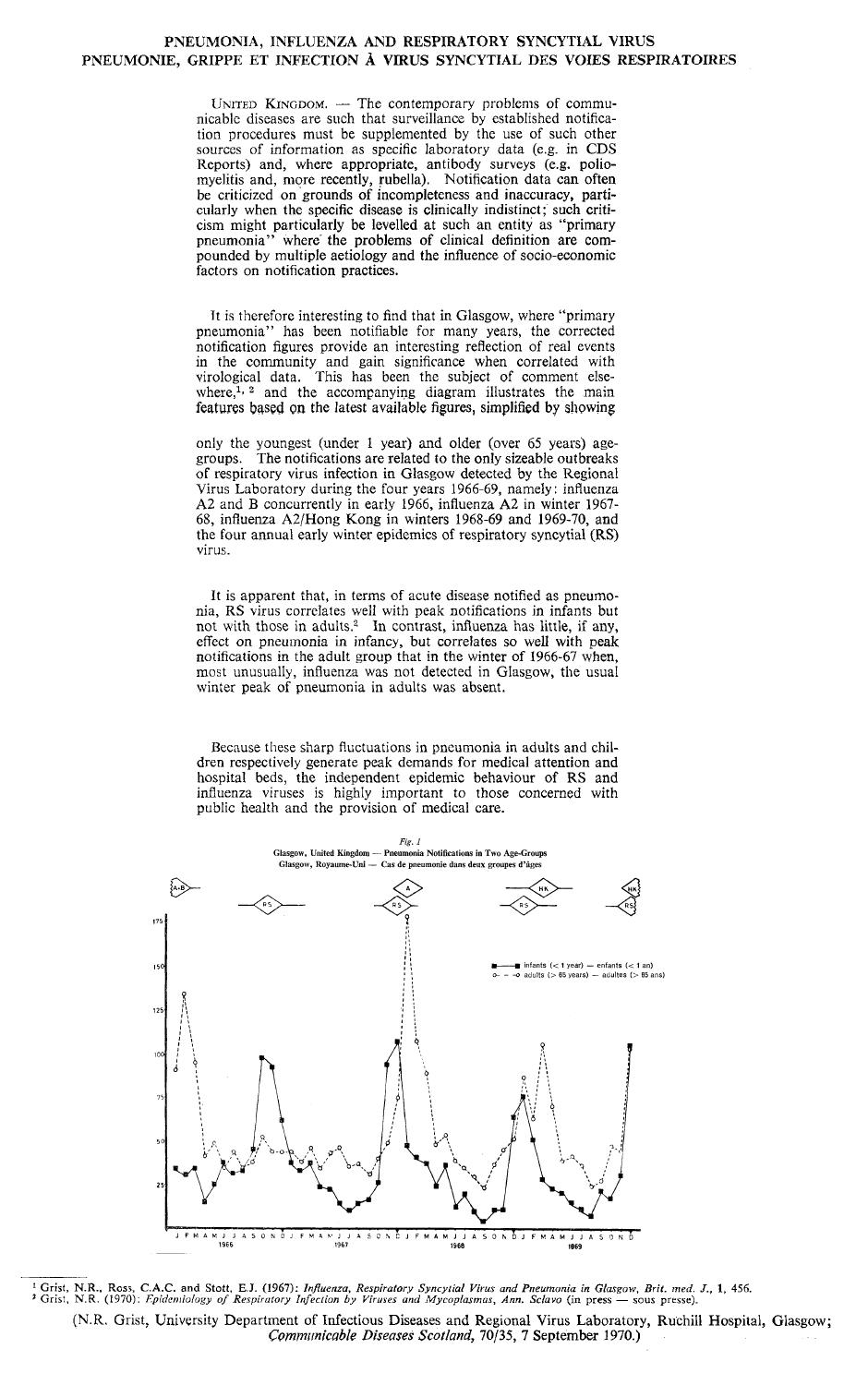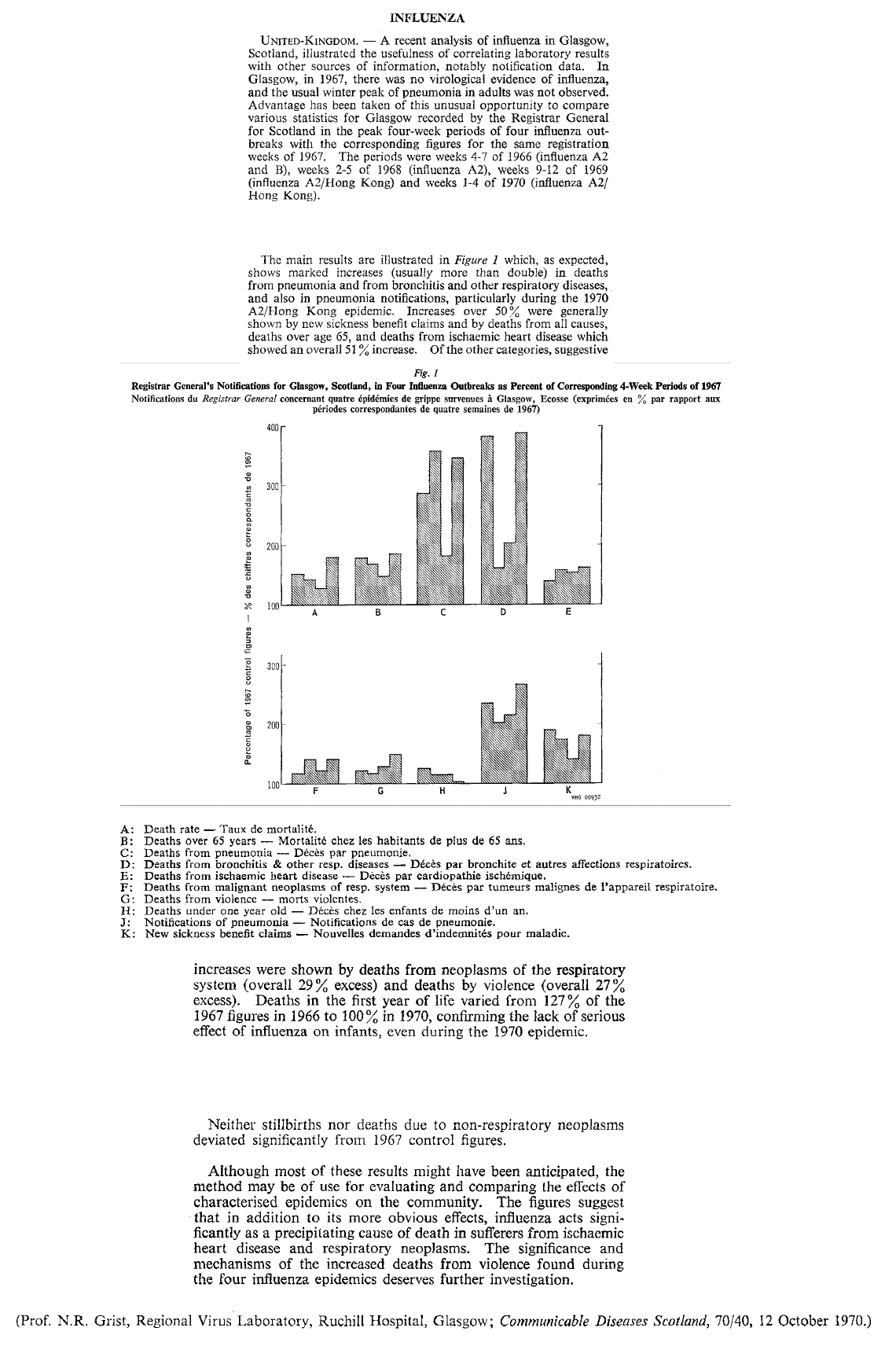During my search for information on the last pandemic, the What began in 1968, I found two interesting statistics in Glasgow, Scotland, which help to better understand the impact of quell'epidemia in winter 1968/69 and 1969/70. As you can see from the first article that I quote in Glasgow in the first year of the pandemic was generally less serious of two outbreaks of seasonal influenza, which are reported in these statistics. In the second year the overall impact of the pandemic, however, was not only worse than the first year, but also of two outbreaks of seasonal influenza considered. Although these statistics are limited in Glasgow, almost all countries had reported that the winter of 1969/70 the impact of the pandemic was more severe than the previous winter in cui il nuovo virus era apparso per la prima volta.
L'idea di fare questa statistica era nata dall'osservazione che nell'inverno 1967 a Glasgow non c'era nessun'evidenza virologica o epidemiologica di un'epidemia influenzale. Questo avvenimento insolito fu sfruttato per confrontare la mortalità fra l'inverno 1967 con due periodo di picco di influenza stagionale e due periodi di picco della pandemia appena passata.
Nella statistica erano state inserite le seguenti 4 settimane di picco epidemico a confronto con 4 settimane corrispondenti dell'anno 1967, rappresentate dalla linea base = 100%. Quindi le barre rappresentano the percentage of excess mortality.
1966: Weeks 4 - 7 (H2N2 - seasonal influenza B +)
1968: Weeks 2 - 5 (H2N2 - seasonal)
1969: 9-12 weeks (H3N2 - Influenza Pandemic Virus "Hongkong")
1970: Weeks 1-4 (H3N2 - Influenza Pandemic Virus "Hongkong")
As expected, the graph shows that when the virus circulates, there is a significant increase in mortality from pneumonia, bronchitis and other respiratory diseases, usually more than double, as well as notifications of cases of pneumonia, especially in the second year of the pandemic. An increase of more than 50% since winter no epidemic can be seen also in all-cause mortality and mortality of persons over 65 years. Mortality from ischemic heart disease rises by 51%. Mortality from respiratory cancer increased by an average of 29% and the violent deaths of 27% (the latter meaning and mecchanismi given in relation to influenza epidemics is to deepen, the author notes). Neither neoplastic diseases that affect the respiratory system nor the number of births increased significantly compared to control 1967. The mortality of children aged 0-1 years is 127% of total mortality in 1966 and 100% (hence no increase compared with no epidemic) in 1970 confirmed that the influence was not a particularly serious impact on their mortality, even in year 1970 pandemic.
Legend: A =
mortality from all causes
B = mortality of persons aged 65 or more
C = D
pneumonia mortality = mortality bronchitis or other respiratory illnesses
E = mortality from ischemic heart disease
F = respiratory cancer mortality
G = H =
violent death mortality of children 0 - 12 months
J = reported cases of pneumonia
K = sickness
The images can be seen in its original format if you click on it and then again to enlarge it.
The other statistic that I found is always about Glasgow and refers to cases of pneumonia. The observed period from January 1966 until December 1969, so in this chart we see the second and more severe pandemic years only the beginning. Still allows you to compare the first year of the pandemic and the flu season last year is the year 1967 in Glasgow where it did not circulate the virus. In fact the winter of 1967 is completely missing the peak of cases of pneumonia in the elderly.
Also this work was carried out by prof. Grist, University Department of Infectious Diseases and Regional Virus Laboratory, Ruchill Hospital, Glasgow. It compared data from the movement of the different viruses with cases of pneumonia, referred to only two age groups, \u0026lt;1 year and> 65 years. In Glasgow, the notification of cases of primary pneumonia was already compulsory da molti anni. Le epidemie corrispondenti sono:
- all'inizio del 1966: influenza stagionale H2N2 + B che avevano circolato contemporaneamente
- nell'inverno 1967/68: influenza stagionale H2N2
- nell'inverno 1968/69: influenza pandemica H3N2(Hongkong)
- nell'inverno 1969/70: influenza pandemica H3N2(Hongkong) - qui il grafico arriva solo fino alla fine del dicembre 1969, come già spiegato
- le quattro epidemie annuali all'inizio dell'inverno dovuti al virus respiratorio sinciziale (virus RS)
As can be seen from the graph, for cases of pneumonia, the RS virus coincides well with a peak of notifications in children \u0026lt;1 year but not in that of adults> 65 years. On the contrary, the influence has little or almost no influence on the cases of pneumonia in young children, but corresponds to a net increase in notifications in adults> 65 years. As already mentioned, the winter of 1967 in which, exceptionally, the influence was not reported in Glasgow, was not observed the usual increase in cases of pneumonia in adults.

Vorrei sottolineare che queste statistiche hanno soprattutto un valore storico, ma non possono essere usate per l'attuale pandemia che è causata da un virus diverso, l'H1N1(2009)v. Penso comunque che è importante vedere il comportamento del virus influenzale A nelle epidemie e pandemie del passato perché aiuta a comprendere meglio le sue caratteristiche.
Si può vedere una certa similtudine fra il primo anno dell'ultima pandemia e quella attuale. Anche allora era parecchio più mite dell'epidemia dell'influenza stagionale che aveva preceduta la pandemia. Solo nel secondo anno il nuovo virus aveva acquistato più forza ed era diventato più agressivo. Il virus pandemico degli anni 1968-70 then became what today is our seasonal flu with which is often confontato the new H1N1 virus (2009) stressed how much more dangerous flu season. So does not mean much for the future development if the H1N1 virus (2009) is mild for the time being, it was also the A/H3N2 (Hong Kong) at the beginning.
is not easy to compare the initial impact of the pandemic 's 1968 with that of the current pandemic, because today many lives were saved thanks to improvements in medicine (intensive care, pharmaceuticals, vaccines etc.). and I think that because of so much information and discussion in recent months, many people have changed their behavior, such as not neglecting the influence and turned in time to the doctor.
Soon I will write other more detailed post on the last pandemic.

0 comments:
Post a Comment